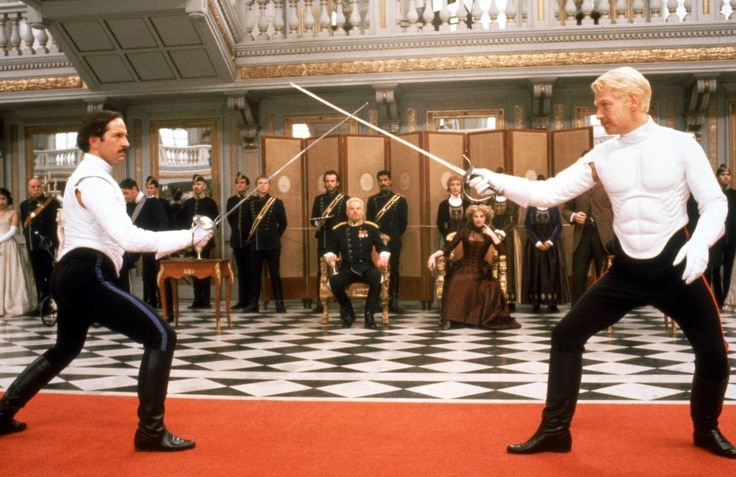
On The Occasion Of The Bard’s Birthday
Today is the birthday of William Shakespeare, who would have been — well, pretty damn old. In pondering a post in his honor I thought of the film adaptations, and the first one that came to mind was Kenneth Branagh’s 1996 version of “Hamlet,” with its grand yet stark interior whose black, white and red color scheme suggests the Third Reich.
If you haven’t seen it, the trailer below will give you a sense of the set decoration. Exteriors for Elsinore Castle were shot at Blenheim Palace, and interiors were done at Shepperton Studios.
This second clip is the duel between Hamlet and Laertes at the climax of the film and play. As a fencer, I can say it’s a pretty good scene. There are some real fencing movements, the kind that are entirely absent in, say, the “Pirates Of The Carribean” movies, which use fight choreographers rather than fencing masters (who are all but extinct in Hollywood). Martial-arts style sword fights in films are all forgettable flash, while ones that use real fencing footwork, thrusts and parries have an entirely different rhythm, and as a result are far more memorable. To wit, the main duel in “The Princess Bride,” which everyone remembers not only for its clever dialogue, but the engrossing swordplay.
In addition to recognizable fencing moves, the actors actually look like they’re trying to hit each other, which is sadly lacking in the kind of unrealistic swashbuckling in which the bucklers of swash look like they’re trying to hit the enemy’s sword rather than the enemy himself.
The most realistic dramatization of a duel, of course, happens in Ridley Scott’s “The Duel,” unfolding at a cautious snail’s pace and with the swords barely meeting at all.
Since this site was launched it’s been on the list do a post about fencing salles. In the meantime, I raise a goblet of hopefully-unpoisoned wine to the greatest writer who ever lived.


I haven’t seen this film yet, but now I will make sure I do! It looks like they are using some type of light dueling saber, but with a made-up hilt. Are you familiar with HEMA (Historical European Martial Arts)?
I would love to see an article on fencing salles , both historical and modern. I am all for dark wood paneling but I also like the look of Angelo’s Fencing Academy: http://www.georgianindex.net/Sport/Angelo/Henry_Angelo.html
Never heard of HEMA. What’s it all about?
HEMA is a revival of the martial arts of Europe which either died out or evolved into something else entirely. The most popular areas of study and practice are the German and Italian methods of Medieval longsword, but other areas include pole weapons (such as spears), wrestling, sword & buckler, rapier, pugilism, Bartitsu, various types of military saber and dueling saber, and the list goes on. Wikipedia has a short entry about it here: http://en.wikipedia.org/wiki/Historical_European_martial_arts
And here is another page that offers a definition of HEMA, what it is and is not: http://hemaalliance.com/?page_id=233
And there are quite a few excellent websites and YouTube channels on the subject. A few of these are:
http://wiktenauer.com/
http://hroarr.com/
https://www.youtube.com/channel/UCt14YOvYhd5FCGCwcjhrOdA
And here are a few schools near you:
http://www.martinez-destreza.com/
http://www.newyorklongsword.com/
I am not a practitioner myself asince I don;t live near an instructor in any of the above mentioned arts, but I have collected antiques swords since age 14 and I would be keen to learn swordsmanship.
I apologize for going so far off topic here, but swords and swordsmanship really get me excited! Keep up the excellent work here–it is much appreciated!
Not so far off topic as one might think, JGH. After all, the post has fencing clips, and what you talk about is very masculine, if not particularly interior.